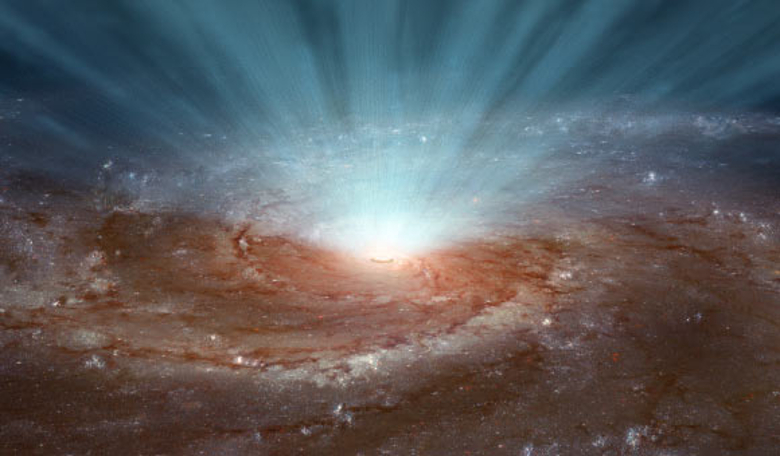It has long been suspected that star formation in a galaxy is put to a stop by the energetic radiation from an active galactic nucleus (AGN) surrounding a black hole residing at its centre. However, the mechanisms responsible for this have remained somewhat unclear. Now, scientists have determined that it is the mass of the black hole that is guilty of shutting down star formation as the galaxy evolves.
The name active galactic nuclei (AGN) is used to describe a very bright region at the centre of a galaxy and as strong emitters of X-rays, ultraviolet and optical light, AGN can be more luminous than the light from the rest of the galaxy put together.
It is believed that this outpouring of radiation is a result of the accretion of matter by a supermassive black hole at the centre of its host galaxy and as the energy is dispersed, it heats and dispels the gas that would otherwise have condensed into stars as it cooled. Nonetheless, observational evidence of a connection between the feedback from a supermassive black hole and ‘quenching’ of star formation has been lacking, until now.
By studying the spectra of light from a number of stars as part of the Hobby-Eberly Telescope Massive Galaxy Survey, a team, led by Ignacio Martín-Navarro, a postdoctoral researcher at UC Santa Cruz, were able to recover a galaxy’s star formation history by finding the best combination of stellar populations to fit the spectroscopic data. "It tells you how much light is coming from stellar populations of different ages," said Martín-Navarro.
What they found was that differences in star formation between the galaxies only correlated with the mass of the central black hole; galactic size, morphology or other properties for instance had no bearing on the results.
"We used black hole mass as a proxy for the energy put into the galaxy by the AGN, because accretion onto more massive black holes leads to more energetic feedback from active galactic nuclei, which would quench star formation faster," Martín-Navarro explained.
"For galaxies with the same mass of stars but different black hole mass in the center, those galaxies with bigger black holes were quenched earlier and faster than those with smaller black holes. So star formation lasted longer in those galaxies with smaller central black holes," added Martín-Navarro.
These new results show that as a galaxy evolves, every generation of stars that are formed are affected by the continuous interplay with the central black hole activity.
"We've been dialing in the feedback to make the simulations work out, without really knowing how it happens," said Jean Brodie, professor of astronomy and astrophysics at UC Santa Cruz and a coauthor of the paper. "This is the first direct observational evidence where we can see the effect of the black hole on the star formation history of the galaxy."
However, not all of the problems have been ironed out, as the precise nature of the feedback from the black hole that puts a stop to star formation still remains uncertain. This is because there are different ways a black hole can release energy into the galaxy; accordingly more work needs to be done to fit these new observations into the simulations.











